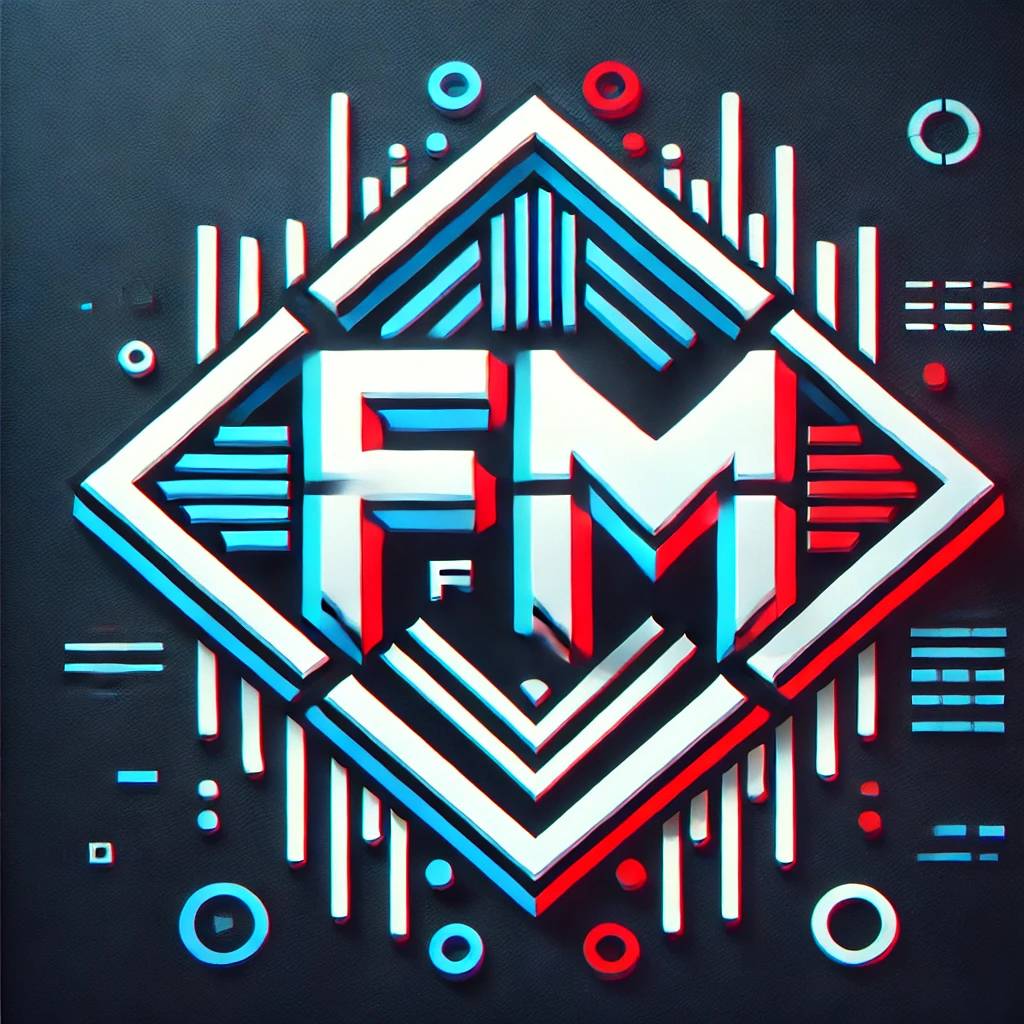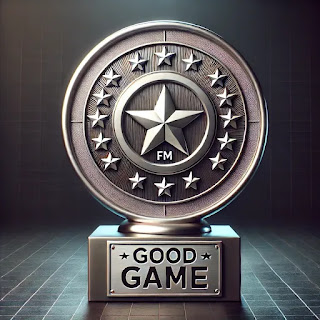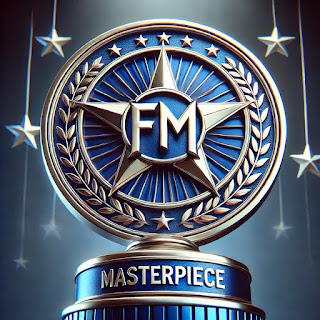My personal experience of Ghost of Yotei, the path of revenge and hatred that brings only misfortune. The student who does not surpass the master.
Cover image: Sony Interactive Entertainment / Sucker Punch Productions
Summary
- 🎮 Name of the game: Ghost of Yōtei
- 📅 Launch date: October 2, 2025
- 🏢 Developer: Sucker Punch Productions
- 📌 Publisher: Sony Interactive Entertainment
- 🖥️ Platforms: PlayStation 5
- ⚔️ Genre: Action, adventure, open world
- 🌍 Context: Independent sequel to Ghost of Tsushima, set in 1603 in Ezo. You follow the story of Atsu, a warrior who seeks revenge against the Yotei Six, who destroyed her home and killed her family 16 years ago.
History and narrative
The game begins by showing us a group known as the Yotei Six, having eliminated an entire family for no apparent reason. Atsu, our main character, survives this massacre and is left with a trauma as a child. As the years go by, Atsu has only one goal in her life and that is revenge; she is completely determined to hunt down each of the members.
Each member has a name; the first one we face is practically in a tutorial and is more of an initial boss than really a serious fight. We face the member known as “The Snake”. The Snake recognizes Atsu and the fight begins, which is fine. The only slightly odd detail is that I honestly don't know how our protagonist survived after the Snake's attack. Being objective, I found it far-fetched not only that she survived, but that she got up and rode a horse after an attack of that magnitude.

The story focuses a lot on the theme of revenge and how it can blind us by prioritizing something that is not. Atsu suffers a trauma that he can't let go of, no matter what happens to the rest; it has its consequences. Really the story is nothing we haven't seen in another game. The good thing is that she does accomplish her main goal in a way, though she realizes that her actions simply hurt her and those around her. Later on she realizes that perhaps she is worth more and that she has a greater purpose than just killing thousands of soldiers.
Beyond this, there is no such deep analysis, as it is a story with no soul or innovation. The only thing different is how they tell you about Atsu's path and how he faces it, but it is a very predictable story and as you advance it is even more predictable. There are decisions that the character makes that perhaps generate a dilemma for you; in my case there was only one, but beyond that it won't blow your mind and it can be a bit of a cliché story.
Spoiler alert:
The beginning of the game is good, Atsu hunting the Snake in a tutorial fight nothing special. The next members of the Yotei six are: the Oni, the Kitsune, the Dragon, the Spider and Saito (the main villain). The Snake is super forgettable and brings nothing to the table. As we progress through the story we learn that Atsu's brother, Jubei, survived, and I really don't know how either, if he gets shot in the chest at the age of 10 at a distance of one meter and, after all, falls from a considerable height. Anyway, he somehow survived and is adopted into an allied clan called the Matsumae, who fight against Saito's army.
The relationship between Jubei and Atsu is nice, one of the highlights of the narrative, in how they develop and realize that the 16 year separation makes when they meet again it's like meeting someone else. The hunt for the Oni has parts that I found incongruous or at least a waste of time. The first time we go to their base we go in as allies because it's packed with soldiers. We fight the jailer Kanta, who they mention in the dialogues that it would be a friendly fight to settle our differences; however, Kanta uses a real weapon while we use a wooden katana, when the Oni himself said he didn't want to see dead people. But still the guy uses a weapon that would break anyone's head. Once we beat him, this scene of stealing the key gave me a laugh and I share it because, really, I understand that it's a game, but nowadays in these games those details can't happen. He steals the key in front of all the soldiers and apparently none of them notice.

Later, when we attack the Oni, he tells us that he already knew it was Atsu and that it was coming for his head. I would think the best thing to do was to kill it when he could, but for some reason he didn't. Atsu's first attempt to assassinate the Oni feels like a complete waste of time, because he fails ridiculously and again you have to go to his base to confront him again. The good thing is that the combat is pretty good.
The chase against the Kitsune can be a bit boring, since a lot of it is solving puzzles, which are solved in the same way and with the same sheet of paper, which loses a bit of fun. In this part we are now accompanied by Oyuki, who is a person dedicated to music in a village in the mountains of Teshio. She helps us search for the Kitsune, where we later learn that Oyuki, our friend, was the Kitsune 16 years ago and was the one who helped Saito kill Atsu's family. I guess this was something I didn't expect and it took me by surprise.
The real Kitsune is a former student of Oyuki's named Dojun. What is interesting about this part of the story is Atsu's dilemma of whether or not to kill Oyuki. Although she seeks to redeem herself by helping us, the crimes she committed in the past are hard to forget. This was the point that made me think the most: should he kill her or not? Killing Dojun felt more about a justice issue than something personal, because in the end Atsu forgives Oyuki. I think I would have been more inclined to eliminate both of them. I know Oyuki was following orders, however, everything he did is not to be taken lightly. The fight with Dojun is good as well. I think the Kitsune section is one of the most interesting on a narrative level, but I found his path to get to him boring.
The Dragon and the Spider turned out to be Saito's children, with the Dragon being the firstborn. Saito's relationship with his children is not the best; he doesn't see them as the big deal, although he sees the Dragon better. We capture the Spider to use him as bait since the Dragon loves his brother and was going to rescue him. For me, the best part of the story is the capture of the Spider. It's like the birth of the new ghost, where Atsu totally loses his mind and annihilates dozens of soldiers who went to see a theatrical play of the massacre of Atsu's family, which is very cruel. This event marks a point where she is consumed by hatred and has only one goal: to kill whoever crosses her path to avenge her family.

The ambush of the Dragon and Saito to the Matsumae castle was very predictable and it was known that the castle was going to fall. Even, as soon as I saw that castle, I said to myself: that place is definitely going to be invaded, and indeed it was. Here Atsu makes the decision to face the Dragon instead of helping Jubei and Oyuki protect the castle and Kiku (Atsu's niece). He manages to kill the Dragon with the consequence that Jubei and Oyuki are captured. Somewhat pointless, and a detail that should never happen in this type of game, is that at this point the Matsumae castle is supposed to have been invaded, taken over and destroyed by the attack of Saito's forces, and you are supposed to leave the area. However, you can return to the castle in the story as if nothing happened. In other games this does not happen; a temporary blockade of the area is created until you progress through the story. I found this an unacceptable detail. A “you may not be able to access this area until you progress” message would have sufficed.
We then confronted the Spider, who had managed to escape after his rescue. His resolution was unsatisfactory. Atsu, after annihilating half of Japan and a guy who made fun of his family's death, decides to spare his life in exchange for telling him where Jubei and Oyuki are. I don't know about you, but I wouldn't have forgiven this guy. That check mark on the list was a fake. He had already spared the real Kitsune and now the Spider. What would they have done?
With the information obtained, now we go and confront Saito in his base, but first we free our allies. We rescue Jubei and see him badly wounded, without armor. Here I already began to suspect something later, and it is that in a dialogue Atsu says to Jubei:
-Is something wrong?
Jubei replies:
-No, just that these Saito soldiers are more difficult than those of the Oni.
Here my alarm bells went off and I said: this guy has no level for a more complicated fight.
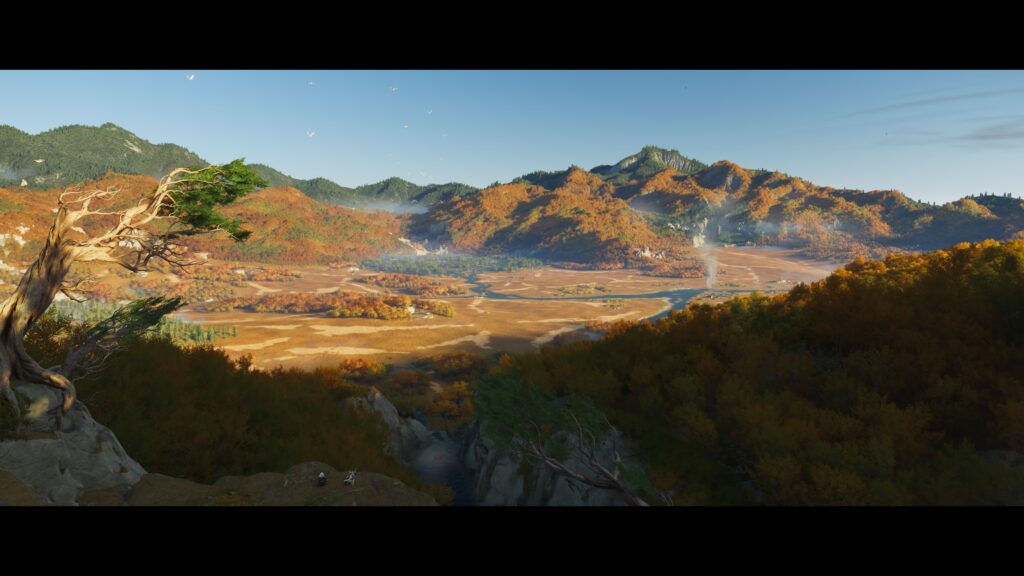
Saito escapes from the base and waits for us where it all started, in the house of the massacre 16 years ago. It's worth noting that there's a mission you can do in a Saito base where you can confront him, and it's pretty much the same as in Ghost of Tsushima, where Jin didn't tickle the Mongol leader's fancy. Well, the same thing happens in this mission; it feels like a filler mission that doesn't end in anything.
Returning to the end, in our second fight against Saito it is now a life and death match. It's a good fight, but not epic. And what I most expected to happen: during a phase of the fight Saito disarms us out of nowhere, without being able to do anything, and Jubei intervenes to simply do what I already saw coming: Saito kills Jubei. To tell you the truth, I wasn't surprised at all, I saw it coming. The beaten guy, no armor, complaining that the enemies are tougher... the game needed an emotional event at the end, and all these signs sang the denouement. Then, Atsu gets even more pissed off and we kill Saito. I would have preferred it to be Oyuki who sacrificed himself or died; I think it made more sense and weight in someone who was looking to redeem himself for his actions in the past. I won't deny that it gave me grief with Kiku; better that she stayed with her father and aunt. But hey, they've decided that Jubei had to die, although I repeat that I don't even understand how he survived from a bullet at the beginning.

Something that also didn't convince me about the story is how and why Saito decides to kill Atsu's family. It's mentioned that it was a betrayal from Kengo to Saito, but there's not much development on this, so you don't end up understanding why the attack happened. I also didn't like that the scenes of what happened were cut. That is, you see flashbacks of what happened, but you never get to connect all the scenes. I would have liked to see at the end the whole scene of how Saito starts the attack to better understand everything.
The characters are average, a few better than others, none stand out. I think you come to appreciate each one. I at least didn't connect so much with Atsu; he's a very cold character, although sometimes the banter with Jubei seemed to me hesitant. It's very hard to empathize with such a cold and straightforward character, whose goal is just to be a hit machine. Jubei didn't strike me as the best either, and neither did Oyuki; they have weight in the story, but they don't end up being awesome either. Saito doesn't turn out to be as intimidating as they make him out to be in the story; he doesn't come across as a powerful leader, and not because of his appearance, but because of his character or what little we can see of him. The rest of the characters aren't very memorable either.
Compared to Ghost of Tsushima, I find Ghost of Yotei to be a considerable downgrade in the quality of the narrative and story. I think this is the game's weakest point, as it has its nonsensical moments, is very predictable, somewhat cliché, and is not a story we haven't seen before. Even the depth of character development between Atsu and Jin is not comparable. Atsu sees that revenge is bad and brings consequences, that he can do better; instead, with Jin it was more a theme of how someone must sacrifice everything they have to survive. It seems to me that Yotei didn't meet my expectations in this section, however, it has very good moments.
Gameplay
Melee combat has changed quite a bit from the previous game. Before it was all about stances, but now Atsu can use Katana, Kusarigama, Odachi, Double Swords and the Yari... too much, honestly. Even watching her run around with all those weapons on her feels awkward. And that's not counting the pistol, the rifle with different types of ammunition, the bow with normal, incendiary and poisoned arrows, the kunais, smoke bombs, the Oni's flame, explosive bombs, metsubishi... in short, a complete arsenal.

I understand that the game wants to offer variety, but in my opinion it is an excess. It's almost impossible to use everything. The system that forces you to choose the right weapon depending on the enemy's weapon sounds good, but in practice it becomes a mess.
For example:
- If the enemy uses Katana, you use Katana.
- If he has a shield, first break it with Kusarigama and then attack with Katana.
- If he uses Yari, he is confronted with Double Swords.
- If he uses double weapons or Kusarigama, you have to use Yari.
- If you have Odachi, then Odachi too.
- If you use a knife or bow, either will do.
So far so good, but when you face several enemies with different weapons, it's a disaster. You have to be constantly switching and remembering which combination worked against whom, and in the meantime you get hit from all sides.
On top of that, now there are parrys: if you get a parry attack and you don't have the right weapon, the hit goes in. And with the speed of combat, many times you don't even have time to change. To make things even more complicated, there are enemies that attack with rifles from afar, and believe me, they are a constant nuisance.
The visual system helps a little:
- Red means dodge.
- Blue block with parry (if you just leave the block pressed, you still get hit).
- Yellow disarms you.
The idea is good, it makes combat more dynamic and fun. But again, having to switch weapons so often is tiring. In 1 vs 1 or boss fights, it's wonderful, it feels fair and exciting. But when you're attacked by several at once, it's pure chaos.
Something similar happens with ranged weapons. Switching between types of arrows, bullets or switching from rifle to pistol is a pain. It feels confusing and impractical. I appreciate that they give us so many options, but it doesn't do much good if in the middle of combat it's hard to access them. In this case, less would have been more.
Don't get me wrong, the combat is very good, feels satisfying and has pace. It's just that sometimes it's not quite fair. Many hits you get hit more because of the weapon change than because of your reaction.
And yes, the camera is still a big problem, just like in Tsushima. Having five enemies on top of you, two shooting at you from afar and not even knowing where the bullet is coming from, is still frustrating.
About stealth, I felt it the same as before. The AI doesn't improve much: many enemies seem to be just there for decoration. They are not very reactive and more than once I killed one next to another without them noticing. I ended up preferring direct confrontations. The good thing is that now you can use the Kusarigama for stealthy ranged attacks, and the animation is great.
Exploration, of course, improved a lot. There are more worthwhile activities, more variety and total freedom to move from the beginning and choose who to hunt first. I really liked the use of DualSense. Although they use it mostly in small details, it feels good that they take advantage of the control. You can light campfires, play the shamisen, cook, forge weapons, paint, and use the guiding wind directly from the controller. There's also a gambling board game, an interesting idea but it doesn't quite shine. It's very simple and can be unfair if you play second fiddle. The guiding wind is back, and it's still excellent. Now you can even play songs for the wind to guide you to undiscovered places, something I found very useful for not wandering around aimlessly.

The controls in general feel good, they are fast and fluid, although the weapon switching could be more intuitive. The interface is clean, doesn't overload the screen, and both the menu and map are very well designed. There's also a cartographer who sells secondary activity locations; useful at the start, but it becomes irrelevant fast, as he pretty much only sells altar locations. Luckily, we still have the guide bird, which takes you to hot springs, wolf dens and more.
One thing I really liked about the combat is the bosses and mini-bosses. The common enemies are varied, but when too many appear at the same time and force you to combine several mechanics, it can get frustrating. On the other hand, the bosses are much better balanced. Here I leave my opinion of the most important ones:
- The SerpentFirst member and introductory boss of the game. Very easy to beat; his combat is slower and simpler. Maybe I would have liked it not to be a tutorial boss, but something with more weight or surprise.
- The OniMy second member, and probably the second most complicated one I faced. He's a huge guy with an Odachi, but he moves so fast that sometimes he seems to teleport with every attack. Very good fight, intense and with rhythm. I leave you a small part of my confrontation in normal difficulty:
3. The KitsuneWe faced it twice. The first one is in a small area, where basically the game tells you: “you better come back more prepared”. In the second one, with better equipment, the combat feels much more balanced and fair. Its phase with the fog is the most complicated, because the camera doesn't help and it's hard to see where the next hit is coming from. Still, it's a very enjoyable confrontation.
4. The Dragon: I loved the arena and the idea of single combat... but not the fact that you have to fight both brothers at the same time: one attacking from afar and the other from up close. Definitely the hardest of the six members, though more because of the unfairness than the challenge. If you have Ginji's armor, it won't be that much of a problem; if not, be prepared to suffer. I faced him without that armor and hated the Spider's bullet spam, the way he disarms you and how the Dragon can use his gun and also block yours. In short: if you don't wear the specific equipment, the combat feels poorly balanced. It could have been much better; truth be told, I didn't like it. I would have preferred a 1 vs 1 as with the others.
5. The SpiderUnlike his brother, this one, which is supposed to be the coward, confronts you 1 vs 1, as it should be. It's a fast and demanding fight, where mastering the parry is fundamental. By this point of the game you should already handle it well. This duel shows how the Dragon should have been: a real fight, intense and with identity. A pity about the outcome, but the fight itself is very well done.
6. SaitoThe hated Saito. He first confronts you using a Yari and basically tells you that you're not worthy of his katana... which, of course, burns. That first fight is good, but is interrupted by the story. In the final fight, the expected revenge comes. Saito has several phases and a longer life bar (or at least it feels that way). Every mistake he punishes you mercilessly. For a final boss, it's pretty well done: the setting, the music, the difficulty and the emotional impact make it a great 1 vs 1 duel.
7. Takezo: True, he's not a member of Yōtei, but he's definitely the hardest boss in the game. A total beast with nothing else to say, honorable mention. I might consider it unfair though.
In summary, good combat, good bosses, good interface, interesting side quests and entertaining exploration. The stealth, however, feels weak, and the AI is unstable: in combat it can become unpredictable, and in stealth... they're practically statues. I really liked the use of DualSense, something that games rarely make good use of. There are a lot of weapons, perhaps too many, as not all of them come to feel useful. Overall, it's a solid gameplay, a lot less repetitive than Ghost of Tsushima, although with details to be improved.
Graphics and visual design
Graphically it is excellent. The models, landscapes, lighting and details in general are very well done. However, compared to its previous game, I don't feel that there is a drastic leap. There are improvements, sure, but for a difference of five years, the change is not as big as I expected. Still, for an open world title it's still completely on par with games of its style and release year.
As in its predecessor, where it stands out the most is in its art style, very, very similar to Ghost of Tsushima. Still, I think it was better worked here, allowing you to admire more of Ezo's landscapes. It is more open than Tsushima and offers a wider exploration of the whole island, something that felt more limited before. For this very reason the spyglass was added, a tool that really comes in handy, as you can now observe distant places without the mountains blocking your view. From a high point it is almost impossible not to see something interesting that catches your eye.
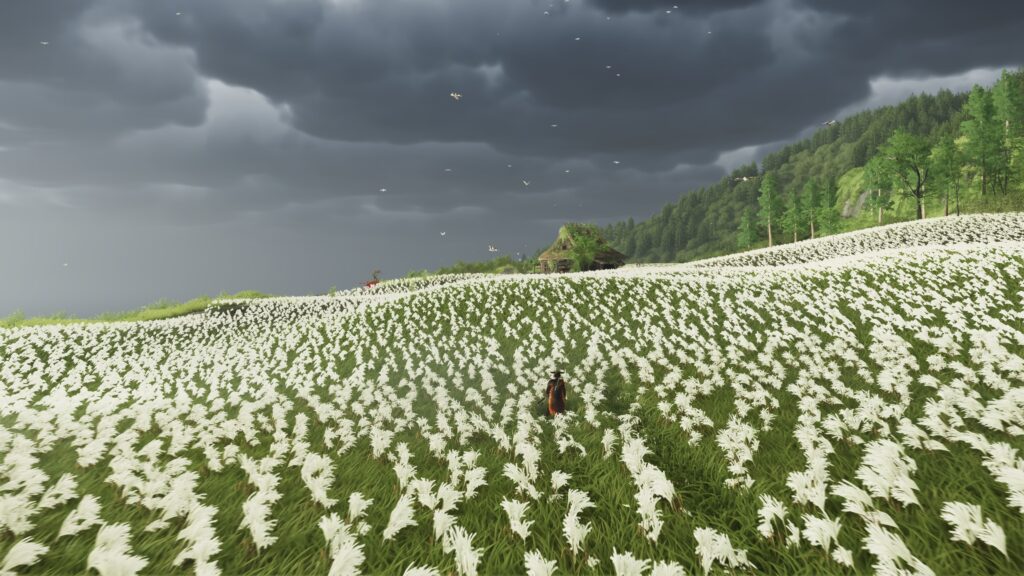
I quite liked the designs of masks, hats, armor and weapons; I have used several. My favorite armor was the spider lily armor, which I found very balanced between defense and agility. On the other hand, I didn't like the ronin sets very much: I felt them too simple and not very protective. The samurai armors, although they look cool, convey a heavy feeling when seeing the character running with them on.
A positive point is that the weapon designs are very well appreciated in combat. In many games, the changes in appearance are hardly noticeable in practice, but here they do look good, although in the fastest fights it is difficult to appreciate them as much as I would like.
The castles of Ishikari and Matsumae are impressive. From afar and up close, they look like real military fortresses, transmitting power and elegance. Personally, the Ishikari castle, due to its location in the mountains, seemed to me a brilliant idea. More than once I stood simply watching it from afar; it is much more striking than other fortresses. The scenery at Yōtei is simply beautiful, especially from the shrines, which are very well located. When you climb a mountain more than 3,000 meters above sea level, you feel an inexplicable peace, and that's what the game manages to convey.
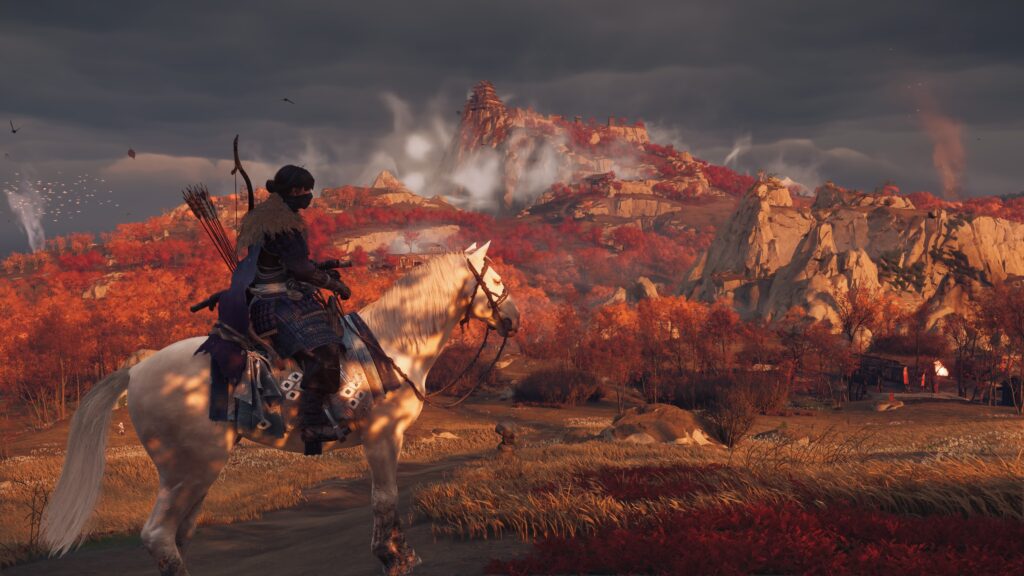
In general, I consider that the world and landscape design surpasses the previous title, although in terms of weapons and armor they are quite even. In graphic quality, I personally prefer Tsushima, since Yōtei I don't think it's a significant leap; they look very similar.
Sound and music
The soundtrack was composed by Toma Otowa and features traditional Japanese music that fits very well with the emotional tone of the story and the protagonist. It serves its purpose perfectly, although I only highlight one song that I really liked and that was the she-wolf song, which you can play with your shamisen. Outside of that piece, I didn't find any particularly memorable themes.
The sound effects are well achieved. I recommend taking full advantage of the DualSense functions to better appreciate this section, as the sounds of nature, wind, snow, vegetation and animals are very present. During combat it complies, although it could be better, especially the sound of the clash between weapons. Perhaps because of the speed of the fights it is not perceived as clear. That said, the sound when you go through an enemy is still as satisfying as in the previous game, although I don't notice any improvements. Where it could be improved is in the effects of gunpowder weapons and in the interaction with other non-human elements, such as animals or objects in the environment. These details always add to the immersion.

As for the voice acting, I played with the Japanese voices and I honestly can't imagine any other way. Hearing characters from that era speaking in another language just breaks the immersion. I fully recommend playing it in its original language. The Japanese performances are very well done, conveying tension, anguish, pain, anger, hatred and redemption. None stand out above the rest, but all maintain a balanced and convincing level.
Difficulty and accessibility
The game has five levels of difficulty, ranging from very easy to very difficult. I played on normal, and although there are complicated fights, it is a fair challenge. It is important to master the parry and improve skills by visiting the altars of reflection, which grant points for very useful techniques in tougher fights.
On bosses I recommend using everything you have at your disposal. If you want to do “honorable” melee combat, go ahead, but I personally use everything the game allows me to: throwing, shooting, whatever it takes.
I would say that the difficulty normal is the ideal point: in difficult becomes very demanding and in easy the combats can be boring. I tried both extremes and normal offers the best balance between fun and challenge. In addition, you can change the difficulty at any time, which is a great success. It also includes a “Custom” mode, which allows you to adjust parameters individually: aggressiveness of enemies, time to parry/dodge, damage received, stealth, among others. This flexibility makes it very accessible and easy to learn.
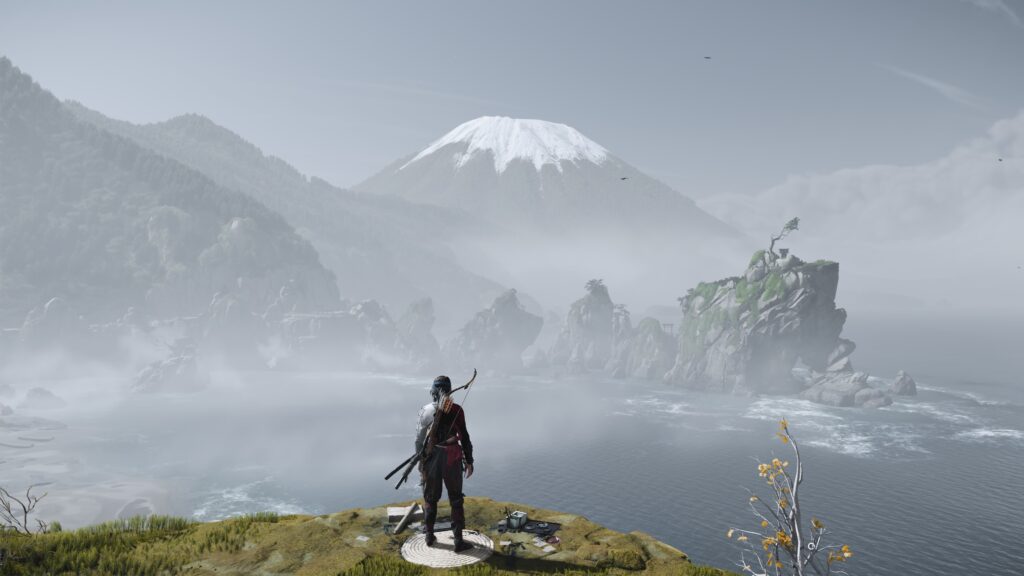
In terms of accessibility, the game offers multiple customization options. You can adjust texts and subtitles, activate the “Wind gust camera.” (which automatically orients the camera towards the direction of the guiding wind), and use the off-screen detection indicator, which shows a white light when an enemy is going to attack you from outside the field of view.
There is also bow or rifle aiming assistance and options to modify the haptic response of DualSense, among others. Overall, it meets today's standards, although there are older games that still offer more options.
Additional content
The main campaign can last between 25 and 30 hours, although in my case it took me longer because it is very difficult not to get distracted by its secondary content. There were days when I only advanced one main mission and spent the rest of the time exploring Ezo.
It has good replayability, as it entertains a lot. The freedom to advance the story, the different combat styles depending on the weapon, the collectibles and the possibility of a future expansion make it a game that is not limited only to complete the story.
The secondary activities are abundant. Compared to its predecessor, this time they expanded the content much more. There are fox and wolf dens, hot springs, reflection altars, NPC quests, mercenary quests (basically bounty hunts), shrines, paintings, songs, enemy camps, bamboo challenges, and short quests that appear when exploring. The latter are not mandatory, but they complement the experience and keep the world from feeling empty.

While the side missions in almost all open worlds tend to be repetitive, here I didn't find them tiresome. Each activity tells a little story or has some detail that keeps it from feeling the same as the others. Overall, they are of good quality.
It is expected that the game will receive DLC or an expansion in 2026, similar to the one that had Ghost of Tsushima, possibly with cooperative or survival mode Legends. And honestly, I have no doubt that it will happen, considering the public reception and sales.
Technical Aspects
The game was released exclusively for PS5 and in this section complies very well. The loading times are excellent and in terms of performance I had no major problems. The FPS remains stable almost all the time, with drops so minimal that they are barely noticeable. In that sense, it was a very good job.
On the other hand, speaking of bugs and glitches, yes... you are going to find them. And in my experience, they are not as well worked as they should be. They can be forgiven if they don't affect the experience, but honestly I saw more bugs here than in Tsushima, and that shouldn't happen. We already know that it seems to be a fashion lately to release games with bugs on all platforms, but it's still something that bothers, especially in titles of this level.
I noticed most of the errors with the enemies. For example: I shot an arrow, and the guy would freeze with the arrow in his eye for two seconds before falling screaming to the ground. On other occasions, Atsu would get stuck between walls and the game would move her as if she were floating. I also encountered enemies standing still, not reacting, just waiting for me to attack them.
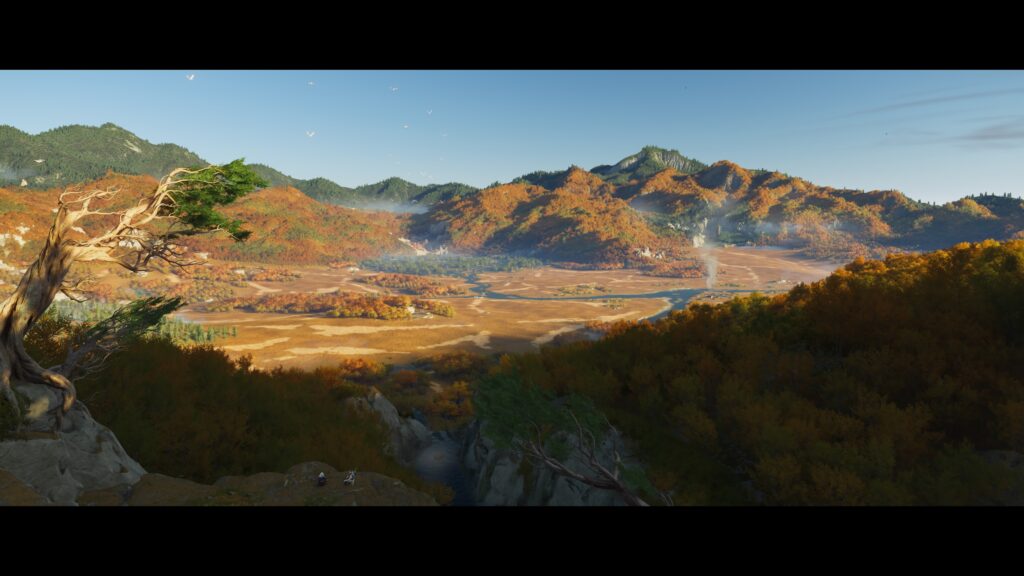
Another time it happened to me that I called the horse and it never appeared. I had to restart the game, and it was only when I reloaded the game that it deigned to come. In a mission with Ina, it disappeared completely; I restarted, advanced to the point where it was lost... and, no lie, it reappeared right behind me out of nowhere.
Nothing game-breaking, but things that shouldn't be there. I'm not surprised: the game came out in early October and in barely a month had already seen three updates. That makes it clear that the performance needed more polish before launch.
Value for money
The starting price was $69.99 USD. Is it well justified? It easily offers more than 60 hours of quality content, with a decent story, good gameplay, excellent graphics and a soundtrack that complies (although it is not the best). Of course, the technical section is where it lacks the most.
Still, the secondary content is very good and I found it less repetitive than other games in the genre. Obviously there is some repetition that always happens in open worlds, but here there are enough different activities to keep it from feeling monotonous.
I bought it outright and feel I paid a fair price. Still, if you see it on sale for around $60, it seems like the sweet spot for me to buy it. Below that, you're definitely getting a very good game.

Trophies / Achievements
- Platinum obtained: Yes.
- Percentage of trophies obtained: 100%.
- Estimated time: About 50 to 60 hours.
- Platinum difficulty: 2 out of 10. This platinum is a must, the game has so much interesting and accessible content that it was impossible for me to refuse to get the platinum. The complicated thing is its duration, but believe me in this game 60 hours will go fast because it is very fun.
Conclusion
Ghost of Yōtei seeks to surpass its predecessor, and although many have criticized it for various aspects, the truth is that many of those points don't matter so much to me. There are others that do, but in the end, I focus more on the experience: if the game entertains me, captures me with its story and leaves me wanting to keep playing, then it has already achieved the most important thing.
There may be decisions or scenes that not everyone likes, but this game has nothing really controversial; the little that has been said in that sense seems silly to me. Personally, I find it a very good game, worthy of being a sequel, with clear improvements in several sections. However, in my experience, it does not reach the level of Ghost of Tsushima, especially in the story and technical performance. In other aspects it does improve, and in some it feels rather stagnant.
Some see it as a simple extension of the previous title, and yes, there are elements that are repeated, but that's something normal in sequels. Personally, I find it exaggerated to call it a DLC, as I've seen in certain comments. It has enough new content to be considered a game of its own, with its own identity.
I had my doubts at first, I was afraid it would be “more of the same”, but in the end it was not. It's a good game and I totally recommend it. If you enjoyed Ghost of Tsushima, you will enjoy Ghost of Yōtei just as much or almost as much. Mind you, being honest, I don't think it deserves the GOTY 2025.
My final rating for Ghost of Yotei is:
4.4/5.0

